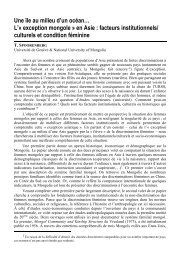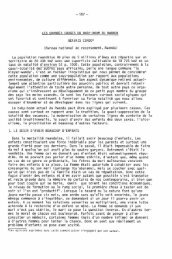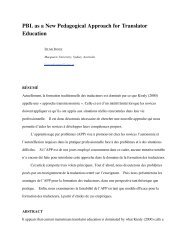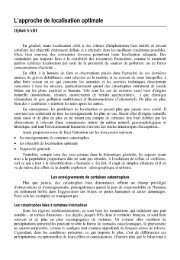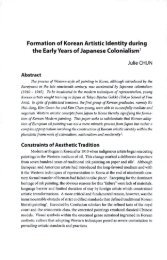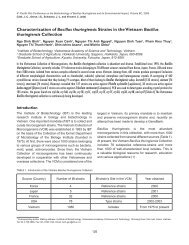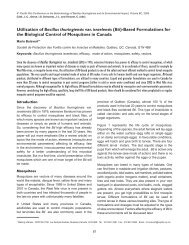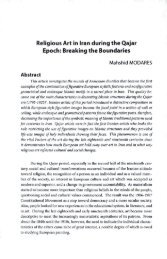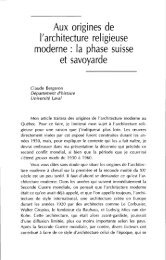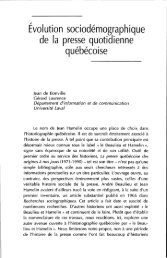A Proactive Approach to the Translation of Bible Stories for Children
A Proactive Approach to the Translation of Bible Stories for Children
A Proactive Approach to the Translation of Bible Stories for Children
Create successful ePaper yourself
Turn your PDF publications into a flip-book with our unique Google optimized e-Paper software.
4. This article is imbedded in a six-year research project by <strong>the</strong> authors. The project is interdisciplinary in nature and<br />
combines <strong>the</strong> collabora<strong>to</strong>rs’ respective expertise in cognitive linguistics and bible, <strong>to</strong> focus on <strong>Bible</strong> interpretation<br />
in children’s literature. The transfer and interpretation <strong>of</strong> bible (religious) knowledge from diverse institutional<br />
and parental sources <strong>to</strong> children: visual and literary interplay. The project is funded by <strong>the</strong> generous financial<br />
assistance <strong>of</strong> <strong>the</strong> South African National Research Foundation’s Thuthuka Program. Any opinion, findings and<br />
conclusions or recommendations expressed in this material are those <strong>of</strong> <strong>the</strong> authors and <strong>the</strong>re<strong>for</strong>e <strong>the</strong> NRF does not<br />
accept any liability in regard <strong>the</strong>re<strong>to</strong>. The financial assistance <strong>of</strong> <strong>the</strong> University <strong>of</strong> <strong>the</strong> Free State is also<br />
acknowledged.<br />
5. Mogomme Masoga (2004: 141-142) on <strong>the</strong> bible as part <strong>of</strong> indigenous knowledge in South Africa: “[…] <strong>the</strong><br />
biblical text stands in a central position. […] It is used daily in a variety <strong>of</strong> contexts – it is used on trains by<br />
preachers; it is used <strong>to</strong> divine and heal by abathandazeli (spiritual/faith healers); it is used […] and read at many<br />
night vigils, by independent and indigenous church preachers and <strong>the</strong>ir followers, in cold tents and shanty buildings,<br />
[…] characterised by singing, clapping <strong>of</strong> hands and pulsating drumming, dancing in cycles and humming <strong>the</strong> songs<br />
with a strong sense <strong>of</strong> African reper<strong>to</strong>ire.”<br />
6. A non-traditional application <strong>of</strong> <strong>the</strong> term “domestication”, but never<strong>the</strong>less, we would argue, applicable in this<br />
instance.<br />
7. Article 6(1): “The <strong>of</strong>ficial languages <strong>of</strong> <strong>the</strong> Republic are Sepedi, Sesotho, Setswana, siSwati, Tshivenda,<br />
Xitsonga, Afrikaans, English, isiNdebele, isiXhosa and isiZulu.” Article 6(5) continues <strong>to</strong> grant <strong>the</strong> Pan South<br />
African Language Board <strong>the</strong> authority <strong>to</strong> promote <strong>the</strong> development and use <strong>of</strong> Khoi, Nama and San languages, as<br />
well as sign language. It also provides special privilege (“respect”) <strong>for</strong> languages used <strong>for</strong> religious purposes such as<br />
Hebrew.<br />
8. Beard & Du Toit are at present in <strong>the</strong> process <strong>of</strong> conducting a survey on <strong>the</strong> publication status <strong>of</strong> children’s bibles<br />
in all eleven <strong>of</strong>ficial languages.<br />
9. To complicate matters, this is an example <strong>of</strong> a hapax legomenon, one <strong>of</strong> 3000 words that occur only once in <strong>the</strong><br />
biblical Hebrew corpus.<br />
10. The parallels are well reflected in a number <strong>of</strong> visual images in picture books, where <strong>the</strong> direction and <strong>for</strong>m <strong>of</strong><br />
<strong>the</strong> staircase <strong>of</strong>ten strongly recalls what we know from archaeology <strong>of</strong> <strong>the</strong> Babylonian ziggurat referred <strong>to</strong> in Genesis<br />
11 (cf., <strong>for</strong> example, Lingo 2003: 22 and Barnes 2001: 29). This parallel reflects <strong>the</strong> textual references <strong>to</strong> “gate <strong>of</strong><br />
heaven”, and <strong>the</strong> like, that tie <strong>the</strong>se two unusual accounts <strong>to</strong>ge<strong>the</strong>r.<br />
11. The Mesopotamian flood narrative, <strong>the</strong> Epic <strong>of</strong> Atrakhasis (first half <strong>of</strong> <strong>the</strong> second millennium BCE), provides<br />
<strong>the</strong> pro<strong>to</strong>typical example <strong>of</strong> <strong>the</strong> apparent indifference <strong>of</strong> <strong>the</strong> ancient Near Eastern deities vis-à-vis humankind. And <strong>the</strong><br />
flood narrative in Genesis and <strong>the</strong> Hebrew deity’s close involvement with humanity in this narrative is <strong>of</strong>ten<br />
considered <strong>to</strong> be a polemic against <strong>the</strong> ancient Near Eastern understanding <strong>of</strong> <strong>the</strong> divine as disinterested and unaffected<br />
by <strong>the</strong> trials <strong>of</strong> humanity.<br />
12. It is predicted that as many as a quarter <strong>of</strong> South African children may be orphaned by <strong>the</strong> AIDS epidemic in <strong>the</strong><br />
next five years.<br />
13. Larsen’s My bedtime bible (1995) takes cognisance <strong>of</strong> this by reorganising <strong>the</strong> selection <strong>of</strong> bible tales<br />
<strong>the</strong>matically in<strong>to</strong> 365 “devotions <strong>for</strong> children”. On Genesis 28, she asks <strong>the</strong> child audience (Larsen 1995: 89), “What<br />
makes you afraid? How do you think Jacob felt after God talked <strong>to</strong> him?”<br />
14. Nahum Sarna (1989: 198): “It should be noted, though, that in Jacob’s dream, <strong>the</strong> sullam [staircase], whatever it<br />
be, does not function as a channel <strong>of</strong> communication between man and God.” And <strong>the</strong> angels on <strong>the</strong> staircase are not<br />
active participants in <strong>the</strong> interaction between <strong>the</strong> two ei<strong>the</strong>r.<br />
15. By contrast, God is <strong>of</strong>ten depicted, in children’s bibles, in relation <strong>to</strong> <strong>the</strong> stairs/ladder. In children’s bibles God,<br />
or a luminous symbolic image depicting <strong>the</strong> deity, stands at <strong>the</strong> <strong>to</strong>p <strong>of</strong> <strong>the</strong> ladder. In this, <strong>the</strong> children’s bibles follow<br />
<strong>the</strong> text <strong>of</strong> <strong>the</strong> King James Version (KJV), a popular pretender-source text: “And he dreamed, and behold a ladder set<br />
up on <strong>the</strong> earth, and <strong>the</strong> <strong>to</strong>p <strong>of</strong> it reached <strong>to</strong> heaven: and behold <strong>the</strong> angels <strong>of</strong> God ascending and descending on it.<br />
And, behold, <strong>the</strong> Lord s<strong>to</strong>od above it, [...]” (Gen 28:12-13a KJV). This rendering disagrees from <strong>the</strong> Hebrew source<br />
text.<br />
RÉFÉRENCES<br />
BARCELONA, A. (2000): Metaphor and Me<strong>to</strong>nymy at <strong>the</strong> Crossroads: a Cognitive Perspective, Berlin, Mou<strong>to</strong>n de<br />
Gruyter.



